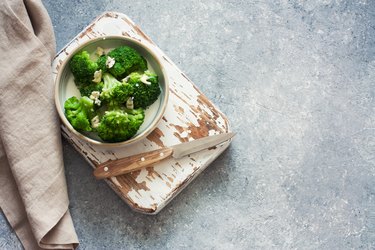
Fresh is best, they say. But fresh isn't always in season … or in your refrigerator. According to the Academy of Nutrition and Dietetics, frozen can be just as nutritious as fresh. And whether sauteed or steamed, frozen broccoli can taste just as good, too.
Roast Frozen Broccoli
Video of the Day
Because of its water content when frozen, it's tough to cook frozen broccoli that doesn't turn out mushy. That's why roasting — a technique that uses high heat and draws out moisture — is one of the best ways to cook frozen broccoli.
Video of the Day
Set your oven at 400 degrees Fahrenheit or above. While the oven is heating up, remove the broccoli from the freezer. Do not thaw it before cooking. Place the broccoli in a bowl with a little olive oil, salt and pepper and toss to coat.
Be sure to use an oil with a medium-high smoke point when you're roasting. The smoke point is the temperature at which an oil begins to smoke and break down. This causes it to lose nutritional value, and it can give foods an unappealing flavor. In addition to olive oil, Mayo Clinic suggests avocado, corn or canola.
When your oven is hot, spread the frozen broccoli in an even layer on a tray. Roast until the broccoli is tender and just starting to brown around the edges. Remove and serve as is, or top with some grated parmesan or a fresh squeeze of lemon juice — or both.
Steam and Boil
Maybe roasted isn't the flavor you're going for. No doubt, steaming is the healthiest preparation method for any vegetable because it doesn't require the addition of oil (although healthy fats from avocado and olive oils are actually good for you.) If you're watching your calories, this is ideal. Plus, according to a review in International Journal of Gastronomy and Food Science in April 2016, steaming is the best way to cook frozen broccoli and maintain its nutritional quality.
To steam frozen broccoli, fill a pot with about an inch of water and place a steamer basket in the bottom. When the water is boiling, put the frozen broccoli in the steamer basket and steam for 7 minutes, or until the florets are crisp-tender. Remove the steamer basket, transfer the broccoli to a bowl and toss with a little olive oil (if desired), salt, fresh pepper and lemon juice.
Boiling is also an option, although why would you boil when you can steam? Boiling often leads to overcooked, mushy and wet frozen vegetables that aren't very appealing. Boiling also leaches some nutrients into the water, which doesn't happen when the vegetable isn't submerged.
Nonetheless, if you must, get your pot of water on the boil. Pour in your frozen veg, bring the water back to a boil and set your timer for two to three minutes. Check the broccoli to make sure it is just tender. If it's not, recheck it every 30 seconds or so. Then drain the broccoli well, transfer it to a bowl and season as desired.
Read more: 15 Healthy 10-Minute Dinner Ideas
Stir-Fry and Saute Frozen Broccoli
To stir-fry and to saute frozen broccoli is to do basically the same thing, just in different vessels and at different temperatures. Stir-frying uses a wok and high heat to quickly cook foods. If you fancy a quick Chinese broccoli stir-fry, all you need is:
- A wok
- Frozen broccoli
- Avocado oil
- Sesame oil
- Garlic
- Dried chili flakes
- Low-sodium soy sauce
Heat up the wok and add enough avocado oil to coat the pan. Dump in your broccoli and start stirring. Unlike sauteing, stir-frying, as its name implies, requires constant stirring so the foods don't burn. Next, add some chopped garlic, a dash of sesame oil, soy sauce and chili flakes to taste. Keep stirring for about 3 minutes, or until the broccoli is tender, then remove from the heat.
For simple sauteed broccoli, heat some olive or avocado oil over medium to medium-high heat in a saute pan. Place the frozen broccoli in the pan, along with any seasonings you desire. Cook for 5 to 7 minutes, stirring frequently. Test the broccoli and remove it from the heat when it reaches your desired level of tenderness.
- International Journal of Gastronomy and Food Science: "A Review of the Impact of Preparation and Cooking on the Nutritional Quality of Vegetables and Legumes"
- Academy of Nutrition and Dietetics: “Fresh, Canned or Frozen: Get the Most from Your Fruits and Vegetables”
- Mayo Clinic: “Which Type of Oil Should I Use for Cooking With High Heat?”
- Extension Utah State University: "Roasting"
- Second Harvest Food Bank: "Soy Glazed Broccoli"